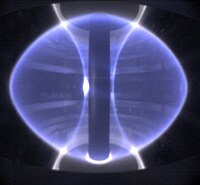
Photo from wikipedia
Plasmas in machines with all metal plasma facing components have a lower Zeff, less radiation cooling in the scrape-off layer and divertor regions and are prone to impurity accumulation in… Click to show full abstract
Plasmas in machines with all metal plasma facing components have a lower Zeff, less radiation cooling in the scrape-off layer and divertor regions and are prone to impurity accumulation in the core. Higher gas puff and the seeding of low-Z impurities are applied to prevent impurity accumulation, to increase the frequency of edge localised modes and to cool the divertor. A lower power threshold for the transition from low-confinement mode to high confinement mode has been found in all metal wall machines when compared to carbon wall machines. The application of lithium before or during discharges can lead to ELM free H-modes. The seeding of high-Z impurities increases core radiation, reduces the power flux across the separatrix and, if applied in the right amount, does not lead to deterioration of the confinement. All these effects have in common that they can often be explained by the shape or position of the density profile. Not only the peakedness of the density profile in the core but also the position of the edge pressure gradient influences global confinement. It is shown how (i) ionisation in the pedestal region due to higher reflection of deuterium from high-Z walls, (ii) reduced recycling in consequence of lithium wall conditioning, (iii) the fostering of edge modes with lithium dropping, (iv) increased gas puff and (v) the cooling of the scrape-off layer by medium-Z impurities such as nitrogen affect the edge density profile. The consequence is a shift in the pressure profile relative to the separatrix, leading to improved pedestal stability of H-mode plasmas when the direction is inwards.
Journal Title: Nuclear materials and energy
Year Published: 2017
Link to full text (if available)
Share on Social Media: Sign Up to like & get
recommendations!